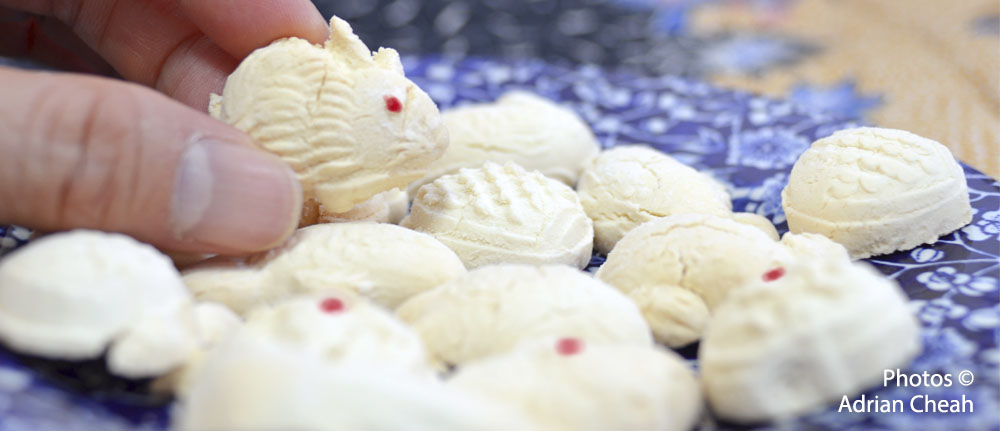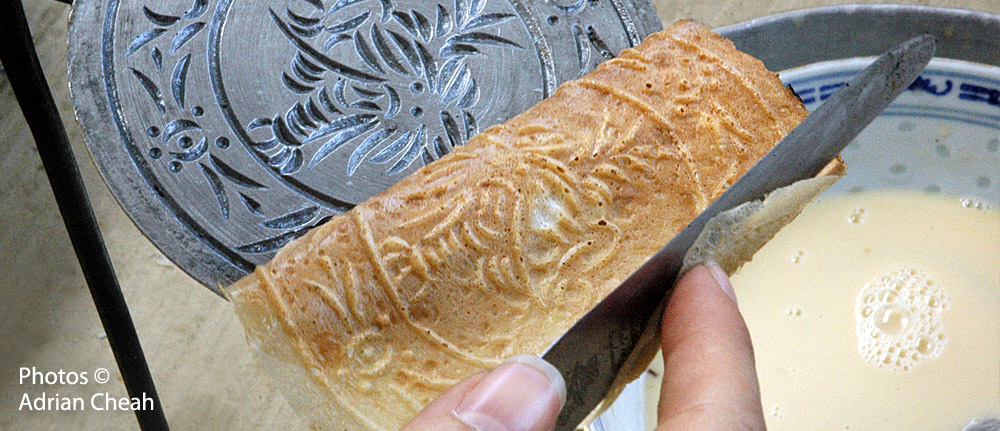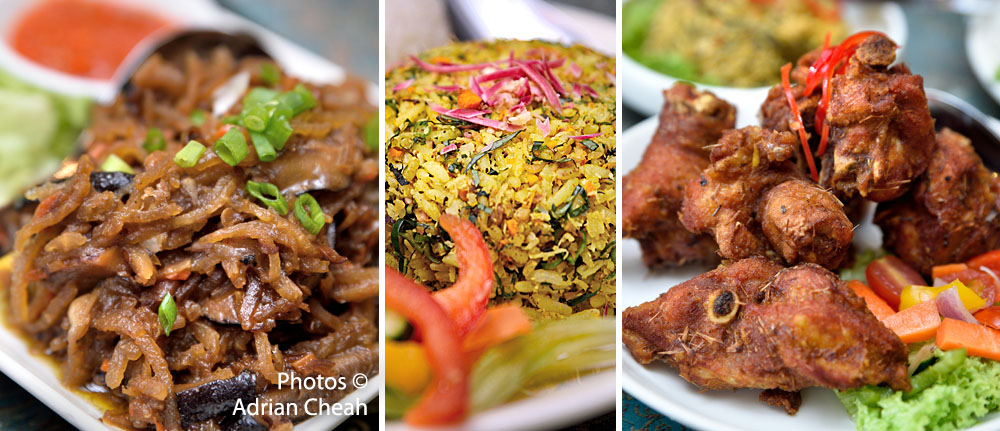Lotuss Nyonya Kitchen – where maximalist style meets maximum flavours

A rendezvous with friends should always set the stage for a fun-filled outing. However, as true-blue Penangites, our palates demand nothing less than something seriously ho-chiak (delicious in Hokkien), the kind that commands attention above all else. This must be closely followed by the thrifty wisdom of value for money. Moreover, if an attractive ambience is coupled with warm friendly service, the escapade would indeed be a memorable one. Lotuss Nyonya Kitchen, located in the heart of George Town, seems to have it all.
Continue Reading
Pomelo kerabu, tu ka chor, inchi kabin and more at Sifu Nyonya Cuisine
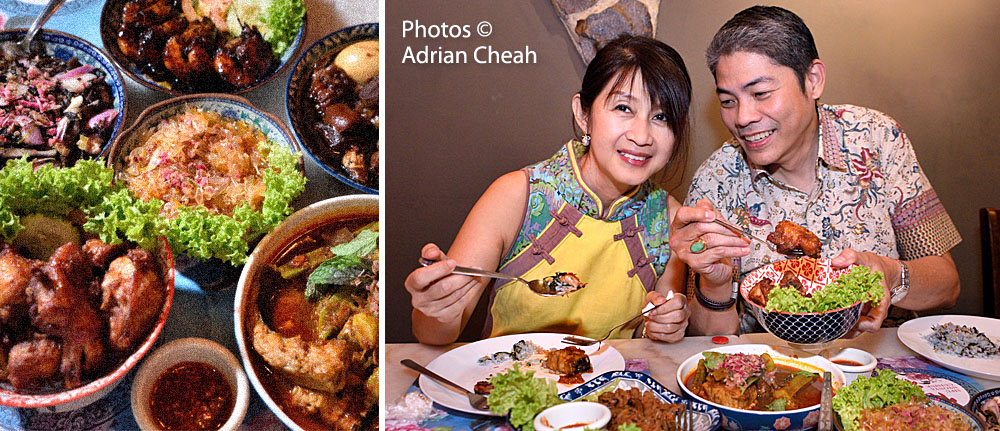
Sifu Nyonya Cuisine, located at Jalan Pintal Tali, offers an authentic Nyonya dining experience. At the culinary helm of the restaurant is 71-year-old Madam Beh Geok Wah, whose culinary prowess is showcased through a menu featuring over 40 dishes. Some recipes are cherished heirlooms passed down through generations, ensuring that the essence of Nyonya cooking is preserved with every flavourful bite.
Continue Reading
Savoury Or Kuih (steamed yam cake) recipe from Lily Wong

"Yam", as it is often known in Penang, actually refers to taro. While "yam" encompasses various plant species in the Dioscorea genus with edible tubers, Or Kuih specifically uses taro. For local authenticity, I'll stick with "yam". Or Kuih, a steamed yam cake, is a lovely local delicacy topped with aromatic shallot oil, fried dried shrimps, crispy shallots, spring onions and diced chillies. Traditionally served with chilli sauce or "tnee cniau" (sweet sauce) on the side, this dish embodies comfort food. A perfect slice of yam cake should be aromatic and tender, with yam chunks that melt in the mouth.
Continue Reading
Springy Nyonya Kuih Talam

Kuih Talam, a classic Nyonya cake, is still popular in Penang today. Its two signature colours are green and white. The sweetened green base layer is perfumed with pandan (screw pine) juice while the top white layer has a "lemak" (rich) indulgence of santan (coconut milk) that is mildly salty. It is dangerously addictive and a slice is never enough. Maybe that is why nowadays, Kuih Talam is cut and packed in two or three pieces. I also notice that the pieces are much smaller than what they used to be when I was growing up.
Continue Reading
Learn how to make authentic Nyonya Jiu Hu Char

“Jiu hu” is Hokkien for “cuttlefish” and “char” means “fry”. Thus, Jiu Hu Char means “fried cuttlefish”. Although the shredded cuttlefish is the star ingredient (providing a potent umami flavour), there is more in that dish than just cuttlefish. The ingredients for this popular Nyonya offering consist of jiu hu si (dried shredded cuttlefish), yambean, carrots, cabbage, pork belly, mushrooms, onions and garlic.
Continue Reading
Kebaya – inventive pan-Asian haute cuisine

The first time I sampled Christopher Ong’s cooking was at a Chinese New Year open house he held many years back. Lam Mee was on the lineup and although it is an uncomplicated dish to prepare, a flavourful stock was necessary to serve up a delicious bowl. With a dollop of sambal belacan on the side, I relish the entire bowl with gusto that day. It was wonderful and had just the right combination of everything a good bowl of Lam Mee would call for. Chris also highlighted that I was eating off an authentic antique Peranakan blue and white batik bowl.
Continue Reading
Tips on making really good Seri Muka

Seri Muka (literally means "radiant face" in Malay) or Kuih Salat is a dainty sweet cake that consists of two layers. The base is made from glutinous rice which is topped with a green custard layer, scented and coloured with pandan juice. Santan (coconut milk) is a key ingredient as it imparts the “lemak” (rich) taste to the glutinous rice as well as the custard layer.
Continue Reading
Bee Koh Moy, a healthy bowl of goodness

In Penang, Bee Koh Moy (Hokkien for black glutinous rice porridge, Bubur Pulut Hitam in Malay) is often served topped with fresh coconut milk. The yin-yang-looking combination of mildly sweetened black rice porridge drizzled with a slightly salty creamy white coconut milk sauce is a scrumptious treat. The rich and creamy dish, perfumed with aromatic pandan (screw pine) leaves, can be served warm or chilled. This offering is usually enjoyed for breakfast, at tea time or as a dessert after a meal; it is best savoured in small portions as it is hearty and filling.
Continue Reading
Colourful onde onde ubi keledek recipe from Madam Lily Wong

Nyonya kuih are colourful Asian sweet cakes that are popularly served for breakfast and afternoon tea and as snacks any time of the day. The selections are many and varied, available at morning markets and food courts throughout Penang. One such type is the explosively delicious onde onde.
Continue Reading
Otak-otak, a savory parcel of fish custard
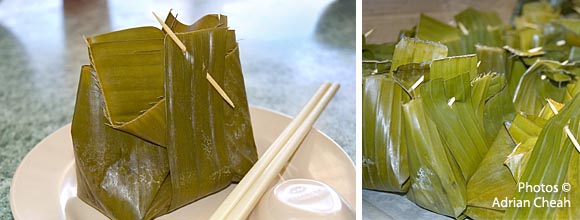
Unwrap a parcel of otak-otak and you will catch a waft of the spicy, delicious egg-like fish custard that is usually served with other dishes common in a Nyonya household. Otak-okak can also be eaten on its own or as an appetiser or even with bread. This popular dish is available at Nyonya restaurants, some food courts and wet markets, as well as a common spread in “Economy Rice” stalls.
Continue Reading





